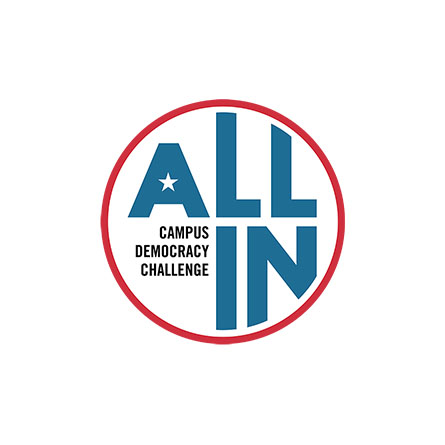
Connecticut College sees 17% increase in student voting rate
Connecticut College saw 77% voter participation in 2020—a 17% increase over 2016—according to a report from the Institute for Democracy & Higher Education (IDHE). This distinction is in addition to the College winning the 2020 ALL IN to Vote challenge for the highest percentage of the student body pledged to vote, placing Conn fifth in the nation and first in NESCAC.
“Voting is one of our most precious rights,” said President Katherine Bergeron. “We are proud that our students take seriously their role as active citizens of our democracy, which is reflected in our stellar voter-participation record.”
In addition, Connecticut College earned a Gold Seal from the ALL IN Campus Democracy Challenge for nonpartisan student voter-participation efforts in the 2020 election. These efforts include Camels Vote, a nonpartisan civic-engagement initiative operated through the Holleran Center for Community Action, which seeks to increase students’ understanding of democracy, civic engagement and voting processes. Initially spearheaded by Jozette Moses ’21 and Julia O’Connell ’21, a website was created in 2020 with the goal to expand voter participation and access. Special events, including panel discussions, were hosted throughout the year to highlight the importance of voting.
“It’s amazing to see an increase in our voting rate despite a global pandemic and systemic challenges to our democracy,” said Angela Barney, assistant director of the Program in Community Action for the Holleran Center.
“I’m extremely proud of our students for their engagement, especially first-time voters, and grateful to those who helped mobilize voters. It is a testament to Connecticut College students’ commitment to civic responsibility and the power of supporting each other to be agents of change. I hope we continue to increase our voting rates and that people keep advocating for the causes they believe in, as there are no off years.”
Nationwide, the IDHE study’s authors report a record-breaking set of findings. On campuses across the country, students built on the momentum swing of 2018 and voted at high rates in the 2020 election, with voter turnout jumping to 66% in last year’s presidential election. The 14-percentage-point increase, from a 52% turnout in the 2016 election, outpaces that of all Americans, which jumped six percentage points from 61% to 67%, according to the U.S. Census Bureau.
IDHE’s National Study of Learning, Voting, and Engagement is the nation’s largest study of college and university student voting. Institutions must opt in to the study, and at this time, nearly 1,200 campuses of all types—community colleges, research universities, minority-serving and women’s colleges, state universities, and private institutions—participate. The data set reflects all 50 states and the District of Columbia and includes 49 of the nation’s 50 flagship schools. IDHE uses de-identified student records to ensure student privacy. The 2020 data set is robust, with 8,880,700 voting-eligible students representing 1,051 colleges and universities.

